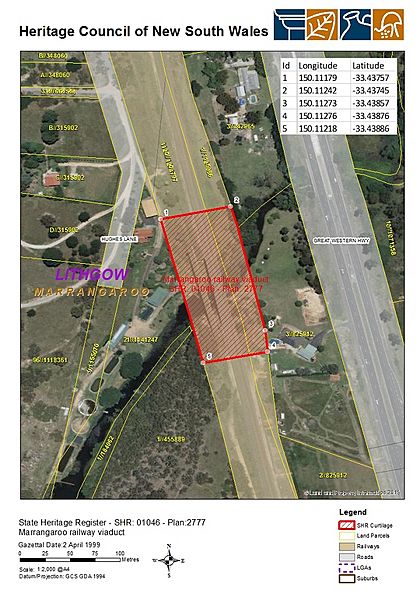Marrangaroo railway viaduct facts for kids
Quick facts for kids Marrangaroo railway viaduct |
|
|---|---|

Heritage boundaries
|
|
| Coordinates | 33°26′17″S 150°06′44″E / 33.4381°S 150.1123°E |
| Carries | Main Western line |
| Crosses | Marrangaroo Creek |
| Locale | Marrangaroo, City of Lithgow, New South Wales, Australia |
| Owner | Transport Asset Holding Entity |
| Characteristics | |
| Design | Viaduct |
| Material | Sydney sandstone |
| History | |
| Designer | John Whitton |
| Constructed by | George McGarvie Donald |
| Construction end | 1870 |
| Opened | 1 March 1870 |
| Official name: Marrangaroo railway viaduct | |
| Type: | State heritage (built) |
| Designated: | 2 April 1999 |
| Reference #: | 1046 |
| Type: | Railway bridge / Viaduct |
| Category: | Transport - Rail |
| Builders: | George McGarvie Donald |
The Marrangaroo railway viaduct is a special old railway bridge. It carries the Main Western railway line over Marrangaroo Creek in Marrangaroo, New South Wales, Australia. This amazing bridge was added to the New South Wales State Heritage Register on 2 April 1999. This means it's a very important historical site that needs to be protected.
Contents
History of the Marrangaroo Viaduct
Building the Main Western Railway Line
The Main Western railway line was built step-by-step. It started from Central station in Sydney. The first part opened to Parramatta in 1855. Then it slowly reached places like Blacktown (1860) and Penrith (1863).
After Penrith, the big challenges were the Nepean River and the Blue Mountains. John Whitton, the Chief Engineer of Railways, came up with a plan. His plan included building the Victoria Bridge over the Nepean River in 1867. It also involved creating special railway tracks called the Lapstone Zig Zag (1867) and The Great Zig Zag (1869) to get trains up and down the mountains.
The railway line reached Bowenfels by 1869. The section to Wallerawang opened on 1 March 1870. To finish this part, several major bridges were needed. These included the Bowenfels rail viaduct, the Marrangaroo railway viaduct, and a stone bridge over the Coxs River at Wallerawang. All these bridges were finished around 1870.
George McGarvie Donald: The Master Builder
The Marrangaroo viaduct was built by George McGarvie Donald. He was a very skilled stonemason and builder from Lithgow. He helped build many important structures in the Lithgow area.
George was born in Paddington in 1846. His father was also a stonemason from Scotland. George learned his trade from his father and uncle. In the late 1860s, he worked on railway projects near Bowenfels. He helped build stone railway bridges at The Great Zig Zag and Marrangaroo.
After the railway work, George moved to Hill End. He built the Hill End Methodist church there. Later, he returned to Lithgow and started a building business. He built churches, schools, and even the Lithgow Town Hall. George was also very active in his community. He became the first mayor of Lithgow in 1889. He even served in the NSW Parliament from 1891.
Design and Features of the Viaduct
The Marrangaroo railway viaduct is about 163 kilometers (101 miles) from Central Station. It has eight stone arches, each about 9 meters (30 feet) wide. These arches are filled with smaller stones.
John Whitton, the Chief Engineer of Railways, designed this viaduct. It was built by George McGarvie Donald, with the help of workers. The bridge crosses Marrangaroo Creek, which was once called Middle River.
Whitton chose to use stone arches for bridges between Emu Plains and Wallerawang. This was because good quality local sandstone was available. This made building stone bridges an affordable choice. Many of Whitton's original stone bridges are still standing today.
In 1923, the railway line was doubled. A new brick and masonry viaduct was built next to the old stone one. This new viaduct has four wider spans, each about 15 meters (50 feet) long.
Why the Viaduct is Important
The Marrangaroo railway viaduct was added to the New South Wales State Heritage Register on 2 April 1999.
This bridge is important because it's one of the first stone arch railway bridges built in New South Wales. It shows the amazing work of Engineer-in-Chief John Whitton. The viaduct is a beautiful and strong curved sandstone structure.
It also has historical importance. It helped the railway system grow in western New South Wales in the late 1800s and early 1900s. It's a great example of how local sandstone was used when money was tight. This bridge is a well-preserved example of an old stone arch railway viaduct.

